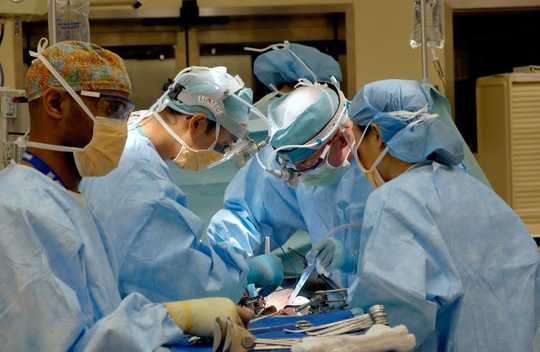 Exercise training can improve your physical fitness incrementally in as little as two weeks, making it a viable option for people about to undergo a surgical procedure. (Shutterstock)
Exercise training can improve your physical fitness incrementally in as little as two weeks, making it a viable option for people about to undergo a surgical procedure. (Shutterstock)
If you’ve had a surgery postponed due to the pandemic, or one is on the horizon, there may be some work you can do right now to prepare and to help improve your postoperative outcome.
Prehabilitation, a strategy that uses exercise to improve patients’ functional capacity before surgery to help improve outcomes, is increasingly recommended for those facing scheduled surgeries, and it’s improving outcomes and experiences for patients across a wide range of situations.
There’s no guarantee, of course, but it gives patients much greater agency over their own health, and it’s never a bad idea to do what you can to lower your risk of complications following surgery.
Postoperative risks
Statistically, dying within a month after an operation accounts for 7.7 per cent of deaths globally, which makes it one of the top three factors contributing to global fatalities, trailing only heart attack and stroke.
Get The Latest By Email
While death is the most severe outcome, surgery patients are also susceptible to additional post-operative complications such as intense fatigue, longer hospital stays or hospital re-admittance, anemia and anorexia among a host of others. Those most at risk post-operatively are generally older adults that already live with other chronic diseases, take various medications and have a lower fitness level.
 The skill of the surgical team is not the only factor that affects the outcome of surgery. (Unsplash/National Cancer Institute)
The skill of the surgical team is not the only factor that affects the outcome of surgery. (Unsplash/National Cancer Institute)
The success of a surgical procedure depends on more than the skill of the medical staff and the complexity of the operation. It is becoming apparent that the likelihood of the patient returning to a physically and psychologically healthy state is also dependent on what they do in the weeks leading up to the surgery.
 Exercise can improve fitness incrementally in as little as two weeks. (Pexels)
Exercise can improve fitness incrementally in as little as two weeks. (Pexels)
Scientists have shown that an effective way of increasing chances of success is to physically train in the time leading up to a surgery. In this time of uncertainty, when many surgeries have been delayed, prehabilitation might be an opportunity to help optimize outcomes.
Doctors are often concerned with a patients’ risk factors, like high blood pressure, blood lipid status or obesity, many of which are difficult to control. Perhaps physical fitness, something you can change with exercise training and impacts several risk factors, should be added to this list. Exercise training can improve your physical fitness incrementally in as little as two weeks, making it a viable option for people about to undergo a surgical procedure.
Prehabilitation
The concept of prehabilitation is based on the idea that patients with a higher functional capacity, or fitness level, will better tolerate a surgical procedure, have fewer post-operative complications and demonstrate better functional, psychological, social and surgical outcomes.
 People with higher functional capacity before surgery may have better post-operative outcomes. (Unsplash/Yulissa Tagle)
People with higher functional capacity before surgery may have better post-operative outcomes. (Unsplash/Yulissa Tagle)
Think of your fitness as a pitcher of water, and each outcome after surgery as a plant. The more water you have at the start somewhat predicts how many plants or outcomes you can care for. Critically, scientific evidence suggests that an individual’s fitness level may be a stronger predictor of post-operative risk than traditional risk factors, as small improvements in fitness have been associated with substantial improvements in survival.
The great news is that we know that many types of exercise training are effective, including brisk walking or jogging, high-intensity interval training, weightlifting, breathing exercises and muscle- or joint-specific training.
The current fitness of the patient is an important factor to consider when prescribing a pre-surgical exercise program, as someone with a higher fitness level will most likely be able to complete a more challenging program, such as high intensity interval training combined with strength training, and will require more activity to see physical gains. By contrast, an older, frail patient undergoing chemotherapy in preparation for a surgical procedure will be more limited in their fitness level, and may only be able to complete deep breathing exercises with a focus on strengthening their inspiratory muscles, which are respiratory muscles used when inhaling, such as the diaphragm.
Preparing for delayed surgeries
Regardless of the specific exercise program, it seems that these exercise interventions are safe, and may be associated with improved post-operative outcomes.
Like training for a race or sporting event, prehabilitation programs are most effective when combined with nutritional and psychological interventions. Surgery induces a stress response causing an increased need for additional energy sources, which can be relieved with nutritional supplementation, such as eating a diet higher in protein.
 People whose surgeries have been postponed due to the pandemic have an opportunity to do prehabilitation. (Shutterstock)
People whose surgeries have been postponed due to the pandemic have an opportunity to do prehabilitation. (Shutterstock)
Addressing a patient’s anxiety regarding pain management, and behavioural modifications like quitting smoking and reducing alcohol consumption, have been shown to independently decrease the risk of postoperative complications. The best postoperative results have been observed when a multi-pronged approach, or a program designed to address all aspects of a patient’s health, has been applied.
In health care, it’s possible to switch gears. If we use prehabilitation and approach surgery like training for a race, we could see better outcomes, fewer deaths and healthier patients. This is even more important now, amid the current pandemic. With so many surgeries delayed, many patients have some extra time for prehabilitation that could improve their outcome.![]()
About The Author
Emily C. Dunford, Postdoctoral Fellow in Kinesiology, McMaster University
This article is republished from The Conversation under a Creative Commons license. Read the original article.
books_fitness







